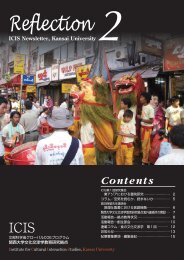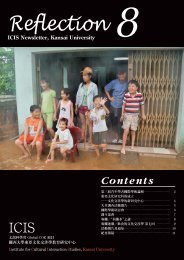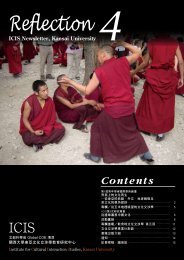English
English
English
Create successful ePaper yourself
Turn your PDF publications into a flip-book with our unique Google optimized e-Paper software.
The 4th ICIS<br />
International Forum<br />
“The Changes of Document Style in Modern East Asia:<br />
Pursuing the Unity of Form and Content”<br />
On December 20th 2009, Kansai University held the 4th ICIS International forum co-hosted by ICIS<br />
and CSAC, entitled “The Changes of Document Style in Modern East Asia: Pursuing the Unity of Form<br />
and Content”. Domestic and overseas scholars presented the following research papers.<br />
Keynote Reports<br />
Three keynote reports were presented: “Notices in Vernacular<br />
Chinese, ‘Shen-yu’ of the Qing Dynasty Government, and the<br />
Vernacular Chinese Literature<br />
Movement in the Late Qing<br />
Period” by XIA Xiaohong<br />
(Professor, Beijing University);<br />
“Transition in Style of Translated<br />
Novels in Modern Korea” by<br />
CHOE Yongchul (Professor,<br />
Korea University); and “Modern<br />
American and European<br />
Perspectives on Chinese Writing Xia Xiaohong<br />
Styles” by UCHIDA Keiichi (Professor, ICIS).<br />
Prof. XIA analyzed notices from the Qing government and<br />
textbooks in vernacular Chinese to reveal their influence on the<br />
vernacular Chinese literature movement.<br />
Prof. CHOE considered a dispute in the translation of western<br />
literature in modern Korea, focusing on “Hongloumeng”, to<br />
investigate the process of translated Korean writing style of<br />
Chinese novels gradually being transformed into simple Hangul<br />
style writing.<br />
Prof. UCHIDA studied various writing styles (classical<br />
language, colloquial language and vernacular Chinese)written by<br />
missionaries to reveal how the westerners learned and understood<br />
Chinese language.<br />
Session 1<br />
The first session consisted of four presentations. YASUDA Toshiaki<br />
(Associate Professor, Hitotsubashi University)reported on<br />
“Whereabouts of ‘Improvement in Writing Style’: Japanese Colloquial<br />
Sentences in Pre- and Post- War Period”; followed by the report by<br />
SAITO Mareshi (Associate Professor, Tokyo University), titled<br />
‘“Kundokutai’ and East Asia in Modern Times”. Then, OKUMURA<br />
Kayoko (Associate Professor, Kansai University)reported on<br />
“Colloquial and Vernacular Chinese Sentences in the Touwa Texts of<br />
the Edo Period”, and ISHIZAKI<br />
Hiroshi (Associate Professor,<br />
University of the Ryukyus)on “The<br />
Language in ‘Ryukyuyaku’ from the<br />
Perspective of Transition of<br />
Sentences in Ryukyu”.<br />
Dr. YASUDA chronologically<br />
followed the wide variety of<br />
movements related to the<br />
Choe Yongchul ‘colloquial writing style’ in Japan<br />
before, during and after WWⅡ.<br />
Dr. SAITO explained how the meaning of kundokutai (Japanese<br />
way of reading Chinese writings)had become the official writing<br />
style in the Meiji Period, through a sociological and ideological<br />
analysis. He further investigated the incident from the perspective of<br />
the establishment of a modern common writing style in East Asia.<br />
Dr. OKUMURA studied the touwa texts, which were documents<br />
written in Chinese during the Edo Period, and revealed special<br />
characteristics of each through a comparison of many documents.<br />
Dr. ISHIZAKI focused on ryukyuyaku (Ryukyu Translation)<br />
edited in 1800, to show how Ryukyu documents had been written<br />
and how Chinese writings had been read there.<br />
Session 2<br />
The second session consisted of four reports. WANG Feng<br />
(Associate Professor, Beijing University)reported on “Early<br />
Translations by Lushun Brothers and Written Language in Modern<br />
Chinese”; TAKEKOSHI Takashi (Associate Professor, Aichi<br />
Prefectural University)o n<br />
“Grammar and Writing Style in<br />
Chinese Conversation Books at the<br />
End of Joseon Dynasty”; CHO<br />
Dongmae (Associate Professor,<br />
Korea University)on “About the<br />
Writing Style of Chinese Novels in<br />
the Late Joseon Dynasty”, and<br />
SHEN Guowei (Professor, ICIS)<br />
on “Writing Style of the First Uchida Keiichi<br />
‘Must-read Book for the People’ in the Late Qing and Early Republic<br />
of China Period”.<br />
Dr. WANG focused on the early translated works by Lushun<br />
brothers to analyze the use of vernacular Chinese style and its<br />
relation to written language through their literary activities.<br />
Dr. TAKEKOSHI studied conversation books at the end of the<br />
Joseon Dynasty to investigate the editorial backgrounds and their<br />
inter-relationships in those books. He claimed that a special style of<br />
Chinese writing had been in use universally in East Asia at that time.<br />
Dr. CHO compared long Chinese novels in Joseon Dynasty and<br />
classical vernacular Chinese novels in China, and revealed the<br />
influence of the latter on the former, as well as the originality of the<br />
former.<br />
Prof. SHEN focused on two representative issues from the wellrespected<br />
“Must-read Book for the People” suggesting the desire<br />
for a simplified edition, the distinction between classical and<br />
vernacular Chinese, and contradictions in style and content and<br />
solutions to this problem.<br />
INOUE Mitsuyuki (COE Fellow, ICIS)<br />
4












